Logitech G703 Gaming Mouse and Powerplay Charging Mat Review
Pros
Cons
Rating
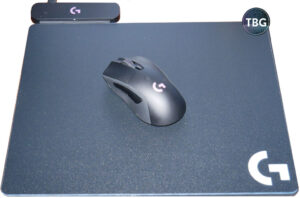
We’ve tested a whole lot of mice over the years, publishing several major peripherals shootouts in 2015 and 2016 to ensure that we could give our readers the very best advice when it came to the right productivity and gaming peripherals. But ever since September 2016, we’ve personally been using one specific mouse: the Logitech G403 Prodigy Wireless. In our review published at the time of release, we called it “The One,” as in the one mouse everyone had been waiting for, which would make all other desktop peripherals obsolete. In large part, this was because of its simply extraordinary wireless connection system, which beat most wired mice in terms of latency.
Today we’re going to review its follow up, the G703, which was released in mid-2017. The key difference was in the G703 Logitech added a revolutionary capability to its already robust wireless capability: wireless charge. Now, you may wonder why we decided to review the G703 and the accompanying Logitech PowerPlay charging mat now, so long after release. Well, the answer is simple: it’s still the very best mousing combo available, and we think all of our readers who have a few extra dollars to spend on top-notch gear absolutely must have it on their desk.
So, we’re sort of giving away the conclusion before we’ve even covered the basics of the product, but it’s important to understand just how revolutionary this product is. Indeed, in the intervening time, two of Logitech’s fiercest competitors, Corsair and Razer, launched wireless that attempted to challenge the PowerPlay system, but ended up falling flat on their face. No other company has the IP to pull this off, and we guarantee you won’t be seeing it in as polished a form for a long time to come.
Of note, since 2016, many smartphones have added wireless charging capability, most using the Qi (pronounced “chi”, as in the internal energy we all harness according to the Chinese tradition). This charging standard, however, require a specific “hot spot”, so a phone needs to be placed very carefully on the charging spot or it won’t initiate charging. This was the technology adopted by Corsair in January 2018 when it launched its PowerPlay competitor, Dark Core. Alas, the Dark Core line had numerous failings, and while charging wasn’t its greatest fault, it couldn’t actually be used while charging – you had to place the Dark Core mouse on a specific spot in the upper-right-hand corner of the mat. That just wasn’t a whole lot better than placing it on a charging cradle, an approach that has been around for at least a decade.
So, while this review is ostensibly an examination of the G703 mouse, it’s really going to look more closely at the PowerPlay system as it works as a whole. If you’re ready for an in-depth examination of a pioneering technology, read on!
Special thanks to Logitech for providing a sample of its G703 Prodigy Wireless Mouse and the PowerPlay Wireless Charging Mat for review.
Description and Features
In terms of size, shape, and features, the G703 doesn’t break much with tradition. In fact, it uses the same exterior shell as the G403, which itself borrowed heavily from previous designs. And that’s not a bad thing. Surveys and product testing has revealed there are certain shapes that feel most comfortable to the greatest number of people, and that shape first appeared in an iconic mouse from the 1990s: the Microsoft Intellimouse. Microsoft is still a major player in the business peripherals market, but at one time, it was practically the only player, and for good reason: it had to make Windows 95, its first fully mouse-driven operating system, appeal to consumers. Without the right mouse, it just wasn’t going to fly.
In short, if you’re used any of the most popular mice of the past few decades, including the Intellimouse, the Logitech G5, or the Razer Deathadder, the G403/G703 will feel familiar. But that doesn’t mean Logitech didn’t add modern interface features, like large, well-placed forward/back thumb buttons, a dual-mode scroll wheel (free or notched), and a DPI selector button, which flips through four presets (which are easily modified via software). What you won’t find on the G703 is a dozen buttons protruding from every corner of the device. If you need a plethora of buttons, whether it be for complex macros or the latest MMO, the G703 may not suffice. Too bad for you!
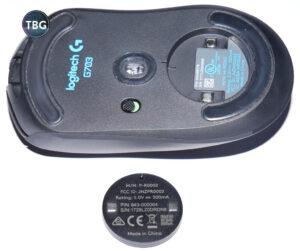
It’s not just the shape of the G703 that makes it comfortable to hold. It’s also the extreme light weight (it comes in at 107g). Most wireless mice that came before the G403/G703 cousins were significantly heavier, typically around 130-150g. This in part comes down to battery technology (two AA Alkalines weigh a whole lot more than a modern lithium pack), but there’s also some smart engineering at play in the G703, which makes it feel sturdy and stable, yet without the extra bulk of competitors. Ironically, the G403 shipped with a 10g weight to allow users to make it feel more like older mice, and in the G703, you still have that option, but the PowerCore module, or “puck” as we’ll call it, actually takes the place of that dead weight. We didn’t actually pop it on our scale, but we’re pretty sure it’s less than 10g. If you need a really heavy mouse to stay in control, you won’t find it here, but we suggest you adapt using an ultralight model, because it’s simply better once you become accustomed to it!
One last thing we like about the G703, which so many other manufacturers get wrong, is the grip on the sides. It has just enough tack to give you a good hold, without being squishy or sacrificing control. Furthermore, many rubber-like materials tend to degrade over time, essentially decomposing in your hand, leaving an unpleasant mess and rendering the device unpleasant to use. We’ve had to throw away our fair share of mice for this reason, but our 2+ year old G403 shows no signs of wear, so we suspect the G703 will hold up just as well.
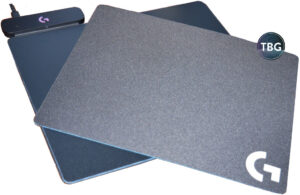
Of course, the G703 is just part of the dynamic duo we’re testing. We also have the PowerPlay mat, and while Logitech could have taken the easy route and just thrown a high-tech solution into a bargain-basement wrapper, it took the high road. The PowerPlay mat feels like a truly premium product. You get a large mousing surface (10.8” x 12.6”), and Logitech provides two mousing surfaces, either of which sits neatly on the charging base. One of the surfaces features a cloth-like material, while the other uses a hard plastic material for ultra-fast responsiveness. These were all the rage in the mid-2000s, and are still popular with some gamers today, but cloth has come a long way in terms of durability as well as decreased friction. We’ve found over the years of using hard mats that while they offer a very slick surface, they take a toll on your gear, eating away slowly at the feet of any mouse due to their sand-like texture. They work in part because they reduce the total surface area that the mouse feet are in contact at any given moment, but that also means there’s more pressure applied per square millimeter (or more likely micrometer!). Another drawback to the hard surface is that it’s not only higher, but has a fairly abrupt edge, which we found more likely to felt on the wrist/forearm during use. We stuck with the fabric surface for most of our testing, but it’s impressive that Logitech provides both options in the package. Given the ample size and dual surfaces of this mouse pad, we’d say it’s easily worth $40 apart from the charging system, so keep that in mind when evaluating its $100 MSRP.
Logitech’s technical marketing manager was kind enough to explain exactly how the mat charging system works, and since we honestly can’t describe it any better, we’re just going to quote him here:
Electromagnetic radiation is generated by an antennae in the pad at a resonant frequency which is then picked up by the receiving antennae in the Powercore, which then takes the AC (alternating current) created by the Faraday principle, rectifies it (turns it into DC) which charges the battery in the mouse.
Cool, right?!? And one nice touch is that the charging cord is the same USB micro-USB cord that can be plugged directly into the mouse, which is great if you need a quicker charge to take your mouse on the go. And yes, unlike Razer’s stillborn wireless solution, the G703 works perfectly on any standard mouse pad, even after you’ve installed the charging puck. The mat includes an RGB-lit “G” logo that matches the mouse, as well as a discrete white LED that shines towards the mat indicating that the mouse is charging. All in all, Logitech had done a great job making a first-of-its-kind product feel very second- or third-gen.
Performance
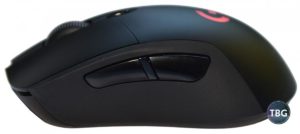
So how does it all work? In a word, seamlessly. When the G703 was released, Logitech renamed its wireless transmission technology “Lightspeed”, and it’s still the best we’ve tested. If you want a wireless gaming mouse that replicates the responsiveness of a wired mouse today, you must have a Logitech mouse. Interestingly, while Logitech’s 12,000dpi Pixart-derived sensor was once cutting-edge, others have released higher-DPI models in the interim. Luckily, that doesn’t matter in the slightest. Mouse DPI ratings are the equivalent of megapixels in cameras: they may be trumpeted by the marketers, but they have no impact on quality once you get beyond a threshold that has long been surpassed. In part, that’s because most office users won’t want their mouse set any higher than 1600dpi, while most gamers will lose control of their games above 3,000dpi. Sure, the 18,000dpi featured on the newest wired mice sounds like it will turn you into Superman, but it’s more likely to make you feel like you have a few screws loose.
Luckily, the Logitech sensor is plenty precise and offers very low latency in tracking directional changes, which is what really counts. We experienced no squirrely mouse movements when using the G703 on the PowerPlay mat, which is still frustratingly-common in some cheaper models. This also ties back into the excellent wireless system; we’ve found that every Bluetooth mouse we’ve used loses track of the surface regularly, even Logitech’s G603, which uses the same exterior shell as the G403/G703. We would have liked it bring excellent performance to the huge market for Bluetooth mice, but ultimately it let us down. Put another way, while Bluetooth is fine for casual use, it has yet to prove itself viable for content creators that need ultra-precise control or gamers who need unflinching reflexes. The G703, on the other hand, would be perfect for either of these target markets.
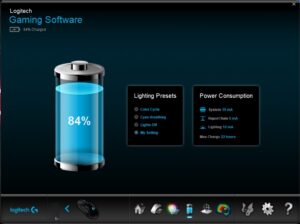
One other aspect of the user experience that we need to mention is just how well PowerPlay fades into the background, never making it known that it’s constantly keeping your mouse charged. The only hint that the system is at work, other than the small white LED on the mat, is that the wireless puck gets warm when charging, which of course is something you don’t need to worry about since it’s on the bottom of the mouse. The mouse shell itself never gets warm, nor does the mat. In part this is because the PowerPlay charging rate is quite low. We found that during constant use, it just kept up when the G703’s RGB lighting was turned off, and slowly let the mouse battery drain when the RGB lighting was on. Luckily, no one uses their mouse constantly, and the PowerPlay system will make up for lost time when you take a break to watch YouTube or get up for a snack. Interestingly, the PowerPlay mat will never charge the battery to 100%; as indicated by the Logitech Gaming System software, and confirmed to us by Logitech’s technical marketing team, keeping the battery in the 85-95% charge range ensures the fewest charge cycles and therefore the longest battery lifespan. Given that the battery is not user replaceable, it’s very good to know that Logitech has given this some thought. While we went into this review assuming that it would either keep it at 100% constantly or let it run down to some very low level and then recharge it, Logitech’s approach makes sense. Maintaining a constant 100% state would mean that the battery would be constantly bumping up against its capacity limit, which puts a lot of strain on it, whereas charging from empty would keep the battery in a charging state for long periods of time. We don’t doubt that Logitech is right in determining that at the PowerPlay’s very slow charging rate, the regular short-duration charge cycles needed to keep the G703 at an 85-95% charge puts the least amount of wear and tear on the battery’s chemical structure.
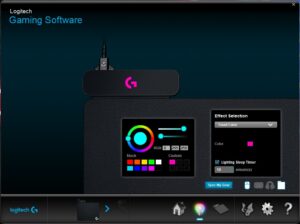
In terms of gaming performance, the G703 maintains the superiority that the G403 established. The combination of instantaneous response, a comfortable grip, and the ultralight weight mean you will never be left flat-footed mid-game. The only aspect of “performance” where Logitech falls behind is in RGB lighting. The G703 and charging mat both sport a glowing Logitech “G” that can be set to a huge range of colors, or to perform rainbow cycles in sync with each other, but honestly, Logitech has to do something to catch up in terms of making the lighting really improve aesthetics.
Conclusion
If you’re just jumping to the end to get the Cliff’s Notes, here’s all you need to know: the G703 with PowerPlay is simply the best-performing, most advanced input device on the market. It’s fast, it’s comfortable, it’s well built, and it’s truly wireless. There are only two questions it leaves us asking: will the competition ever be able to catch up, and how will Logitech possibly top this product?
Answers may be coming soon. In terms of competition, Corsair will be rolling out a whole lineup of wireless mice based on its new Slipstream technology, but Corsair has never released a truly acclaimed mouse design, so it’s definitely playing from facing a headwind. Then there’s Logitech’s own G903, released around the same time as the G703, which features a more aggressive gamer style and a gaggle of buttons, but uses an ambidextrous layout. Our hunch is that where Logitech goes from here is to release a more button-heavy mouse with more radical styling than the G703 (starting with cooler RGB effects), while maintaining its ergonomic right-handed shape. We’d personally appreciate if a thumb rest were sculpted into the left side, but we know not everyone loves these, and Logitech may not want to alienate any current users.
With all that said, if you’re willing to budget around $175 to your mouse, which is admittedly a lot, you simply will not be let down by the G703 PowerPlay combo. As of our publication date, the Logitech G703 Wireless Gaming Mouse is available for $83 from Amazon, while the accompanying PowerPlay Charging Mat is available for $98. The two can also be purchased in a combo package for the same price ($181).
For all our latest recommendations in the keyboard, mouse, mousepad, and game controller categories, check out our Peripherals Buyer’s Guide, updated quarterly.

